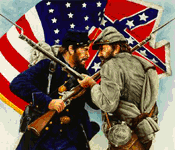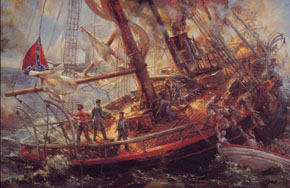 |
Civil War Battles |
|
State War Records |
| AL - AK - AZ - AR - CA - CO - CT - DE - FL - GA - HI - ID - IL - IN - IA - KS - KY - LA - MA - MD - ME - MI - MN - MS - MO - MT - NE - NV - NH - NJ - NM - NY - NC - ND - OH - OK - OR - PA - RI - SC - SD - TN - TX - UT - VT - VA - WA - WV - WI - WY |
The Sinking of C.S.S. Alabama
June 16, 1864 in Cherbourg, France
 |
|||||||||||||||||||||
|
The C.S.S. Alabama was 1 of 3 vessels built in 1862 by the British government for specific use as a privateer. The ship was sent to Egypt for final outfitting since to have been fitted out the ship in England would have violated neutrality and drawn England into the war. Initially, the vessel was known as Ship No. 290, and was a 3-masted wooden vessel without armament. On August 24th, 1862, conversion into an armed raider was completed. Pres. Jefferson Davis formally commissioned the vessel as the armed steam-sloop C.S.S. Alabama.
Union representatives in Europe lodged strong protests with the French government for allowing a known privateer access to French harbors. Union representatives were well aware that the sympathies of many European countries, though not openly expressed, lay with the Confederacy. They realized that if there were to be and end to the Alabama's raiding, a Union warship would have to be brought on ststion at the harbor.
On Sunday, June 12th, the U.S.S. Kearsarge, an 8 -gun, 1,083-ton sloop with a crew of 162 men, was lying at anchor off the Dutch coast when Cpt. John A. Winslow received word that the Alabama, which he had been chasing fruitlessly for the better part of a year, had steamed into the French port of Cherbourg to discharge prisoners, take on coal, get an overhaul, and be refitted. She had just had her 71st naval victory also Winslow set sail immediately, reaching Cherbourg 2 days later. In deference to international law, he assumed a position in the English Channel, just beyond the 3-mile territorial waters limit. And he waited.
Capt. Raphael Semmes, the Alabama's captain, was faced with the decision of either spending the remainder of the war interned by the French government, as they could no longer protect the Alabama without jeprodizing their own neutrality, or engage Winslow, who defiantly was sailing his ship just beyond the harbor as if baiting his old friend to fight. Semmes decided to fight his wat out even though the Kearsarge outgunned his vessel, and by the time he sailed, at 9:45 A.M. on the 19th, crowds of French onlookers were on hand to watch the battle. Word had spread of the impending battle, and there wasn't a vacant hotel room to be found in all Cherbourg.
Winslow was reading the Sabbath service to his crew when the watchman announced: "She's coming out and she's headed straight for us!" With that, the captain hastily concluded services, beat to quarters (summoned all hands to battle stations), and headed for more open waters, so that the Alabama, if crippled, could not find easy refuge. Winslow wanted a fight to the finish.
At 10:57 A.M., with the 2 vessels a mile apart, Alabama opened fire with a 100-pounder. Semmes fired again and again, but Winslow was closing so fast that Alabama's shots were all to high. The gunners could not adjust their trajectories quickly enough. Only after he had closed to half-a-mile did Winslow return fire.
The 2 commanders and crews were a study in contrast. Semmes and his gunners fired rapidly and wildly, whereas Winslow and his men were methodical in pacing and aiming their shots. Winslow fired about 173 volleys- half of what the Alabama got off- in the course of a little over an hour, but far more of them found their mark.
Finally, the Alabama received a hit which destroyed her engine and began to sink. Semmes struck the colors and hoisted the white flag. Shortly after noon the Alabama dissappeared beneath the Channel waters. As Semmes and his crew abandoned ship, Winslow launched his only 2 boats that had not been smashed by Confederate shells. Realizing that these would never hold the Alabama's entire crew, Winslow called out to a British yacht that had sailed out to watch the battle: "For God's sake, do what you can to save them!" Semmes and 40 men of his crew were rescued by the English yacht which returned them to the French shore. The remainder of the crew, except for 12 men killed in the action, were taken prisoner abourd the Kearsarge.
The romanticized legend of the Alabama was increased with her sinking. The ship's doctor, David H. Llewellyn, refused to abandone the ship with wounded on board and went down with the ship. Although Alabama was by no means the last of the Confederate privateers, she had been the most productive. Her destruction caused a great sigh of relief from Northern merchantmen.
